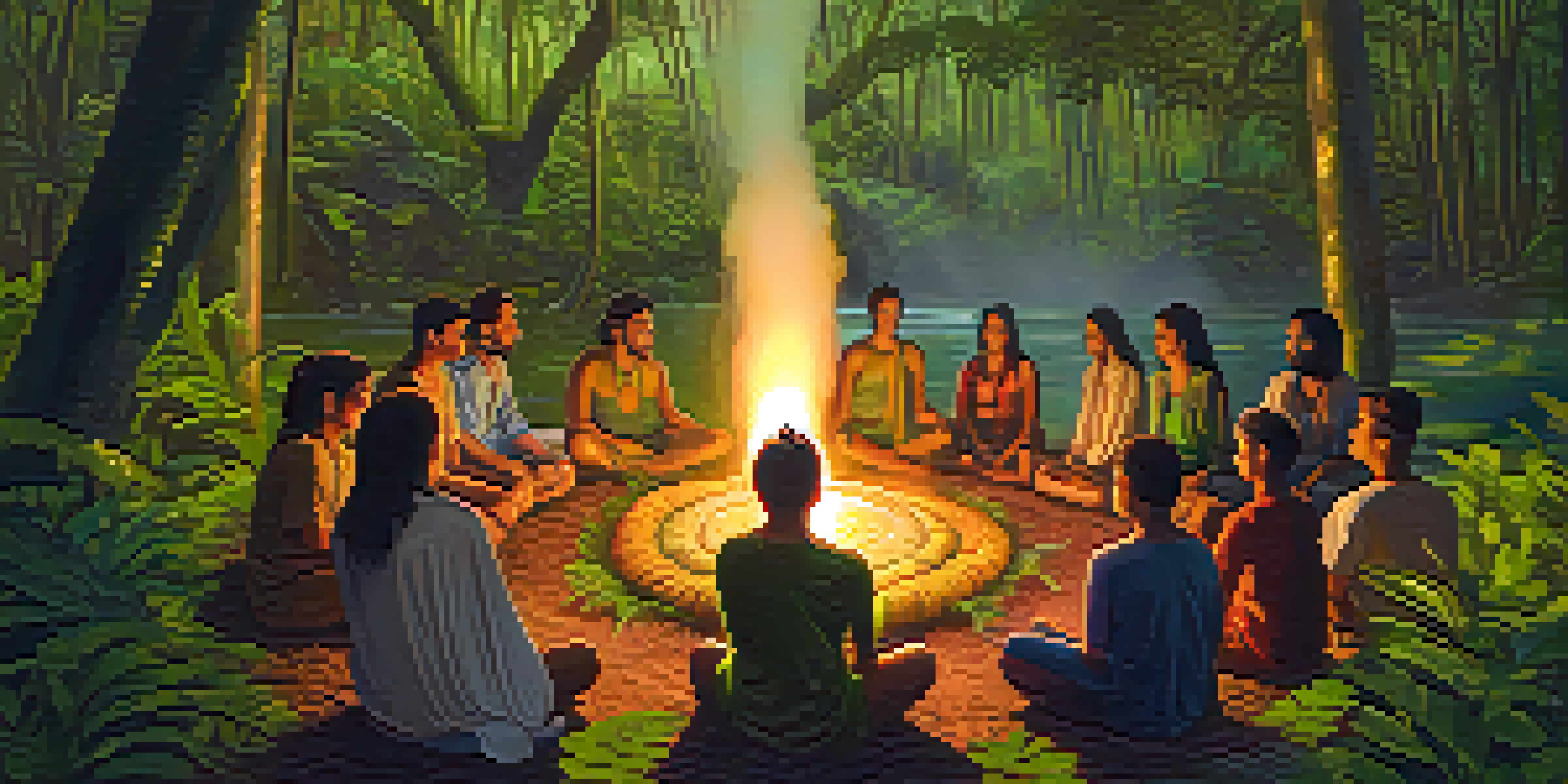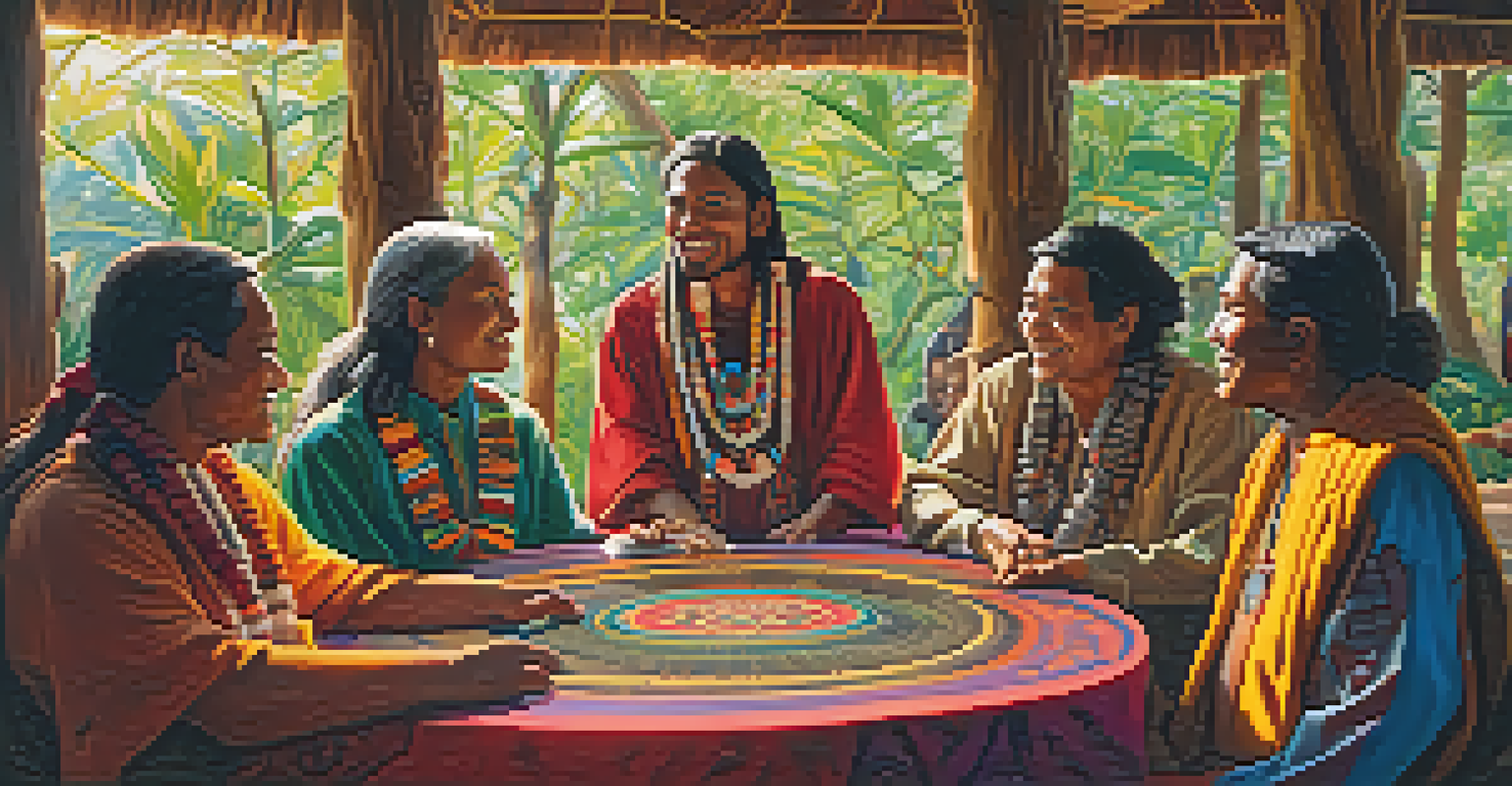Creating Safe Spaces: Ayahuasca and Community Support

Understanding Ayahuasca and Its Healing Properties
Ayahuasca is a powerful brew made from the Banisteriopsis caapi vine and other plants, traditionally used in Amazonian cultures. It’s known for its psychoactive properties, primarily due to the presence of DMT, which can lead to profound spiritual experiences. Many people seek out Ayahuasca to confront personal challenges, heal emotional wounds, or gain insights into their lives.
Healing is not a solitary journey; rather, it thrives in supportive environments where individuals uplift one another.
While Ayahuasca can be transformative, the experience can also be intense and overwhelming. This is where the importance of a supportive community comes in. Having trained facilitators and a nurturing environment can help individuals navigate their journeys safely, ensuring that they feel grounded and protected.
Moreover, the communal aspect of Ayahuasca ceremonies can foster a sense of belonging and connection. Sharing experiences with others who are on similar paths can be incredibly validating, creating a safe space where vulnerability is welcomed and supported.
The Importance of Safe Spaces in Ayahuasca Ceremonies
Creating a safe space is crucial for effective healing during Ayahuasca ceremonies. A safe environment allows participants to let go of their fears and inhibitions, making it easier to explore their inner landscapes. This involves not only physical safety but also emotional and psychological support from facilitators and community members.

In these ceremonies, participants often experience deep emotional releases, which can be challenging without a supportive framework. A safe space encourages open communication, where individuals can express their feelings and concerns without judgment. This kind of atmosphere not only enhances the experience but also promotes healing.
Safe Spaces Enhance Healing
Creating a supportive and safe environment is crucial for participants to explore their emotional landscapes during Ayahuasca ceremonies.
Additionally, safety protocols are essential. This includes having medical professionals available, ensuring that participants are informed about what to expect, and providing aftercare support. By prioritizing safety, the community reinforces the trust needed for a powerful healing journey.
Building Community Support Networks
Community support is vital for those engaging in Ayahuasca experiences. These networks can provide not only emotional backing but also practical resources, such as organizing ceremonies and sharing knowledge about the process. When individuals feel connected to a community, they are more likely to seek help and guidance.
In every community, there is work to be done. In every nation, there are wounds to heal. In every heart, there is the power to do it.
A supportive community also helps set realistic expectations for participants. Sharing stories and experiences can demystify the process and alleviate fears. Additionally, it encourages accountability, as individuals are more likely to stay committed to their healing journeys when they know others are invested in their well-being.
Furthermore, these networks can extend beyond the ceremonies themselves. Continued support through group meetings or online forums fosters lasting connections, which can be invaluable as individuals integrate their experiences into daily life.
Cultural Context of Ayahuasca Use
Understanding the cultural roots of Ayahuasca helps appreciate its significance in healing. Indigenous communities have used this sacred brew for centuries in rituals aimed at spiritual and physical healing. Respecting these traditions is essential for anyone seeking to engage with Ayahuasca, as it honors the lineage and wisdom behind its use.
Many Westerners seek out Ayahuasca without understanding its cultural context, which can lead to misappropriation. By learning about the traditions and practices of the indigenous people, participants can approach their experiences with humility and reverence. This awareness can also enhance the sense of community among participants, as they share a common respect for the origins of Ayahuasca.
Community Support is Essential
Building strong community networks helps individuals navigate their Ayahuasca experiences and fosters lasting connections for ongoing healing.
Additionally, fostering cross-cultural dialogue can enrich the Ayahuasca experience. Collaborating with indigenous leaders and shamans in the community helps bridge gaps and promotes mutual understanding, creating a more authentic and meaningful environment for healing.
Navigating Challenges in Ayahuasca Experiences
While Ayahuasca can lead to profound insights, it’s not without challenges. Participants may encounter difficult emotions or confront traumatic memories during their journeys. Having a supportive community to help navigate these challenges is crucial, as it can provide reassurance and guidance.
Facilitators play a key role in this process, as they are trained to help participants work through difficult experiences. They can offer techniques for grounding and emotional processing, ensuring that individuals feel supported throughout their journey. This kind of professional guidance is essential for fostering a safe space where healing can occur.
Moreover, sharing challenges within the community can be cathartic. When individuals articulate their struggles, they often find that others have faced similar issues, creating a sense of solidarity. This collective understanding not only fosters healing but also reinforces the community’s role as a safe haven.
Integration: The Key to Lasting Change
Integration is the process of making sense of the insights gained from Ayahuasca experiences. It’s important for participants to have ongoing support as they reflect on their journeys and apply newfound knowledge to their daily lives. A strong community can facilitate this process, providing a platform for discussion and reflection.
Workshops, group discussions, and one-on-one counseling can all be part of a robust integration strategy. These avenues offer participants a chance to explore their experiences in depth, ensuring that the healing doesn’t end when the ceremony does. This ongoing support is crucial for lasting change and personal growth.
Cultural Respect Matters
Understanding the cultural roots of Ayahuasca is vital to honor its traditions and enhance the healing experience for all participants.
Additionally, community members can hold each other accountable, encouraging continued exploration and self-improvement. When individuals commit to their integration journeys together, they foster an environment of mutual support and shared growth, which deepens the overall healing experience.
Conclusion: Embracing Healing Through Connection
Creating safe spaces through Ayahuasca and community support is essential for fostering healing and transformation. By prioritizing emotional and physical safety, communities can help individuals navigate their journeys more effectively. The bonds formed within these communities can lead to profound personal growth and lasting change.
As participants share their stories, they not only heal themselves but also contribute to the collective well-being of the community. This interconnectedness reinforces the idea that healing is not a solitary journey; rather, it thrives in supportive environments where individuals uplift one another.

Ultimately, the combination of Ayahuasca and community support creates a powerful framework for healing. By embracing both the individual and collective aspects of this journey, we can foster lasting connections that resonate far beyond the ceremonial space.